75 Sqn Vampires at Ex Golden Kiwi 1969
75 Squadron RNZAF - Exercise Golden Kiwi/Cook Bi-Centennial, Gisborne, September/October 1969
‘Exercise Golden Kiwi’ was the name given to 75 Squadron support to New Zealand’s 200th year commemoration of the landing at Gisborne, New Zealand, by Captain James Cook in 1769. Supporting the ‘Cook Bi-Centennial’ saw the squadron involved in a variety of flying operations over the Gisborne-East Cape area of New Zealand while we camped on the airfield at Gisborne Airport from 30th September until 13th October 1969.
By the end of September 1969 I had a total of 402 flying hours, 155 of which were on the Vampire aircraft that I had flown since joining 75 Squadron in January 1969. The squadron deployed to Gisborne on Tuesday 30th September 1969, and I flew Vampire FB5 NZ5765 on the 40 minute flight as number 7 of the 9 aircraft formation.
Without the extra fuel provided from the two bulky 100 gallon under wing drop tanks (when fitted), the Vampire had a fuel capacity of 330 gallons of jet fuel (AVTUR), and at low level, the Vamp used close on 330 gallons per hour. With a standing requirement to be on the ground after final landing with a minimum of 30 gallons in the tanks, the Vampire had enough fuel for a useful sortie length at low level of only some 45 to 50 minutes – and a little longer if some of the flight was at higher level where the fuel usage rate was lower. Vampire pilots learned very quickly to be extremely vigilant in regard to fuel used and fuel required to get home safely. Thus, in the case of the Vampire, it would be true to say that experience was gained by the number and type of sorties flown, rather than the flying hours attained.
Welcome to camping – After our arrival at Gisborne we had to set-to and put up the tents in which we would live and work throughout Exercise Golden Kiwi. At that time, the RNZAF was transitioning from using the older style tents that had a centre ridge-pole, guy ropes and tent-flys and so we had a number of the newer type of pipe-framed modular tents. Once all hands had helped to erect the larger ‘cook-house’ tent and the big communal dining hall marquee tents, the modular-type working accommodation tents used for sleeping were erected. Each of these tents needed to be properly pegged-down, and in the tents that were used for sleeping an additional inner layer of white insulating cloth was fixed into place.

In his 2013 book ‘Iggy’s Air Force Tales’, page 41, Ian (Iggy) Wood (a Pilot Officer in 1969) said under a story headed ‘A Costly Gesture’ : “Late on the first day of our tented camp at Gisborne Airfield, we were setting up tents. Light rain had set in. Having transported its first load of people and equipment from Ohakea, the Bristol Freighter was on its way to Ohakea to pick up the second load. The loading ramps, used for access to the large nose doors, were left lying adjacent to our line of parked Vampires ready for use when the Bristol Freighter returned. A local top dressing pilot returning to Gisborne carried out his standard rejoin over top of the camp at somewhere between 50 and 100 feet. He landed adjacent to the camp and taxied at high speed to his parking spot, making a less than friendly gesture in our direction from the cockpit as he passed. We, of course, were waving back at him in an endeavour to alert him to the obstacle right in front of him. His Cessna 180 hit the loading ramps at high speed, tore off its undercarriage legs and skewed around with its propellor chopping up the ground. The pilot stepped out of his aircraft and without even looking at the damage walked across to us. “Where’s, the bar?” he asked. “The first round’s on me.”
I can recall that some pilots had not got around to pegging down their four or six berth modular tents before the evening meal was served, which in turn was followed by a mass adjournment to the local Pub. While away at the Pub a very strong squall preceded some heavy rain, so any unpegged tents were blown around and ended up in badly twisted mess of pipes and canvas. One issue discovered on this camp was the number of breakages of the many 4-way connections that joined the pipes making up the tent frames, and this was due to the constant fretting movement of the pipes and frames in the prevailing winds. The cure undertaken after the camp was to retrofit bracing strands onto each arm of the 4-way connecting joints.
We were completely self-contained at the camp with tents for everything including food, work, medical, stores and recreation. Toilet facilities were provided in separate male and female tents with wooden seated ‘cans’ (portaloos came years later!). In those days, for a ‘quick pee’, males used open-aired ‘gonophones’ that had one end inserted into the ground and were surrounded by scrim – but in later years use of gonophones ceased to be used as they did not meet with good health and safety practices. Water heating for both the kitchens and showers was done by way of what seemed to be fairly lethal petroleum-based immersion heaters placed into 44-gallon (200 litre) drums of water. It was the job of rostered junior airmen to awaken early and start the heaters so that hot water would be available in time for showers by the masses.
The camp showers were the product of a great ‘number-8 wire’ Kiwi invention. A two-bucket shower was the norm and the procedure was that a person arrived at the respective male or female communal shower tent, wearing flip-flops, with a towel covering non-public bits, and a jacket if it was cold. On arrival inside the shower tent the first task was to collect two empty 20 litre plastic buckets. A trip back outside the shower tent saw the two buckets filled with water from one of the hot water filled 44-gallon drums, with a little cold water added as required to get the temperature in the buckets just right. Back inside the shower tent the handle of first bucket was connected to a hook at one end of a rope that went up through a pulley on a beam above the shower area. The other end of the rope was then pulled so as to raise the bucket above head-height before the rope was secured to a tent peg in the ground, thus keeping the bucket with warm water aloft. Stripped of the towel the person stood under the bucket and pulled a looped string in the bucket that had a small lead ball fixed into it – the purpose of the lead ball was to fill a hole to stop water from running out of the shower rose in the bottom of the bucket. Having got wet, the person pulled the string in the opposite direction to shut off the flow of water before shampoo and soap were used as needed. The water flow was then activated again by pulling the looped string to wash off the suds. The second bucket was there merely to enjoy the shear luxury of having a warm shower. Throughout all this process, the person stood on wooden duckboards covering a rudimentary open drain that carried the used water away to a soak pit. The showers worked a treat but it was a bracing process to follow on a cold morning.
Local Exercise flying – While at Gisborne we did a lot of flying in support of a Forward Air Controller (FAC) course that was run to train two FACs (Fg Off Bruce Donnelly and Fg Off Daryl McEvedy) who were soon to depart New Zealand for war service in Vietnam; we also flew attacks with practice weapons at Volkner Rocks weapons range located in the sea adjacent to White Island in the Bay of Plenty, and we did three ‘notable’ Diamond 9 flypasts.
My first Exercise Golden Kiwi flight from Gisborne was on Wednesday 1st October wherein I flew Hi- with Fg Off Jim Jennings as aircraft captain in Vampire T11 NZ5707 on a Hi-Lo-Hi profile to Volkner Island and return. The 50 minute flight to Volkner and return saw Jim dropping practice bombs and firing 2 inch HVAR rockets at the rock – this was all new stuff to me as I had only ever used the land-based Raumai air weapons range adjacent to Ohakea, and positioning the aircraft over the featureless open sea at Volkner was a new challenge.
My second exercise flight was also on 1st October where I was number 2 of a 2 aircraft sortie (2 of 2) tasked as Mission 107 with a FAC coordinated simulated attacks on a number of targets. Flying Vampire FB5 NZ5751 on the 45 minute sortie, we carried out a pairs close formation takeoff from Gisborne and flew at low level in ‘lo battle’ formation to a pre-arranged holding point (HP) where we contacted the FAC. The FAC gave us instructions to proceed from the HP on a designated heading for a nominated time and speed before entering an orbit at some six to eight thousand feet (which was above the threat of simulated small arms fire). The FAC, flying in a Harvard trainer, then described the ‘target’ to we the ‘fighters’ using a technique of going from big features to small, and sometimes using coloured smoke grenades popped by a ‘friendly’ troop on the ground. Once the ‘target’, such as a farmer’s barn or a small bush-clad area, had been identified and the location of the ‘friendly forces’ clarified, the fighters set up to attack with simulated bombs from the FAC designated safe attack heading. After a number of attacking runs were carried out by the fighters, the FAC surveyed the ‘target’ and passed a Mission Report to the fighters, which in turn was relayed to the tasking authority on return to base. Of course, all this was without any actual weapons being dropped, but at least it gave good practice to the two ‘trainee’ FACs including locating the target, devising a plan of attack and giving clear instructions to the fighters, and good in-house cockpit management – and all this before the FAC’s own departure to Vietnam to face the ‘real thing’.
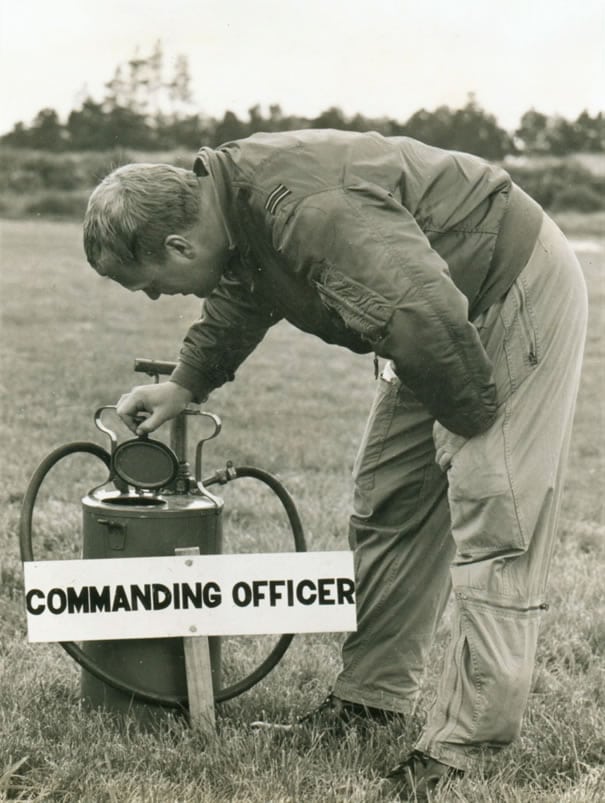
I had four flights on Thursday 2nd October: the first was in Vampire FB5 NZ5774 where I was 2 of 2 tasked as Mission 205 to do a road reconnaissance (recce) of the main highway 35 from Hicks Bay (near East Cape) to Gisborne. To conserve jet fuel we flew north at higher level to Hicks Bay before descending to low level (about 500 feet above ground level [AGL]) to ‘recce’ the 180 km of highway, along the way passing Ruatoria and Tolaga Bay before reaching Gisborne. In the flight duration of 1 hour, we had a purpose including counting the number of trucks moving between two points, noting any military presence, or something similar; another purpose would have been to conduct a low altitude fly-by of any schools seen along the way.
My second flight on Thursday 2nd October was again in Vampire NZ5774, this time as Mission 208 tasked to do a pre-planned low level interdiction strike against a nominated target. Flying this 45 minute mission as a solo aircraft, this flight gave me practice at planning and flying a sortie to simulate dropping bombs, or firing rockets, at a target.
My third flight on Thursday 2nd October was as 3 of 3 tasked as Mission 209 to attack Volkner Rock. Flying Vampire FB5 NZ5770, the 45 minute flight saw us climb to altitude to transit to the Volkner area before descending into the bombing and rockery pattern in order to fire or release actual practice weapons, before a high level return to Gisborne for a ‘buzz and break’ from close formation over the airfield.
My fourth flight on 2nd October was as 20 of 2 tasked as Mission 213 in Vampire FB5 NZ5772. This 40 minute flight involved us waiting on the ground to be ‘scrambled’ for takeoff responding to a call from the FAC who needed immediate air support. We were no doubt given instructions to fly to a designated HP and follow the procedure as per my second flight on 1st October. On landing back at Gisborne, and after ‘debriefing’ with the Tactical Operations planning team, a beer or two at the Bar Tent was most likely the next most important pre-dinner task.

Friday 3rd October brought three flights for me: the first was as 2 of 2 on Mission 301 tasked with a road recce from Hicks Bay to Gisborne. The 50 minute flight in Vampire FB5 NZ5772 no doubt had the same purpose as did the recce I did the previous day. My second flight was again in NZ5772 as 2 of 2 on Mission 307, this time for 55 minutes on another FAC controlled simulated attack. And my third flight that day was as Mission 312 in Vampire FB5 NZ5767, again as 2 of 2 for 50 minutes on another FAC controlled mission.
Saturday 4th October brought two flights: the first was as Mission 401 tasked with doing a weather recce in the exercise rea. Flying as 2 of 2 in Vampire FB5 NZ5776 for 50 minutes we were required to check the prevailing weather and report back via radio to base as to whether conditions were suitable to carry out the planned FAC strikes that day. The second flight for me was as Mission 406 wherein I flew Vampire NZ5772 as 2 of 2 for 50 minutes on FAC controlled simulated attacks.
There was no exercise flying for the squadron on Sunday 5th October, and if my memory is correct, I may well have played 18 holes of golf at the Poverty Bay Golf Club with Inspector ‘Stormy’ Knight of the Gisborne police – I had met Stormy at an earlier Inter-service Golf championship.
Flying for the new week began for me with three flights on Monday 6th October: the first was as Mission 601 flying Vampire FB5 NZ5751 as 2 of 2 for 45 minutes on a ‘road recce’. My second flight was as 2 of 2 on Mission 606 in Vampire FB5 NZ5765 for 50 minutes on a FAC controlled strike; and my third was as Mission 610 in NZ5774 for 35 minutes as 2 of 2 doing a pre-planned simulated strike at a place called Waireki.
Tuesday 7th October brought another three flights for me: the first was as Mission 702 tasked to drop weapons at Volkner Island weapons range. As 2 of 2 in Vampire FB5 NZ5774 I fired 2 inch rockets and dropped practice bombs in the 1 hour flight. My second flight was for 50 minutes as 2 of 2 in NZ5776 on Mission 705 tasked with FAC controlled simulated attacks. My third flight was in Vampire FB5 NZ5774 for 50 minutes – I was 7 of 9 aircraft carrying out a practice for the forthcoming Diamond 9 flypasts.
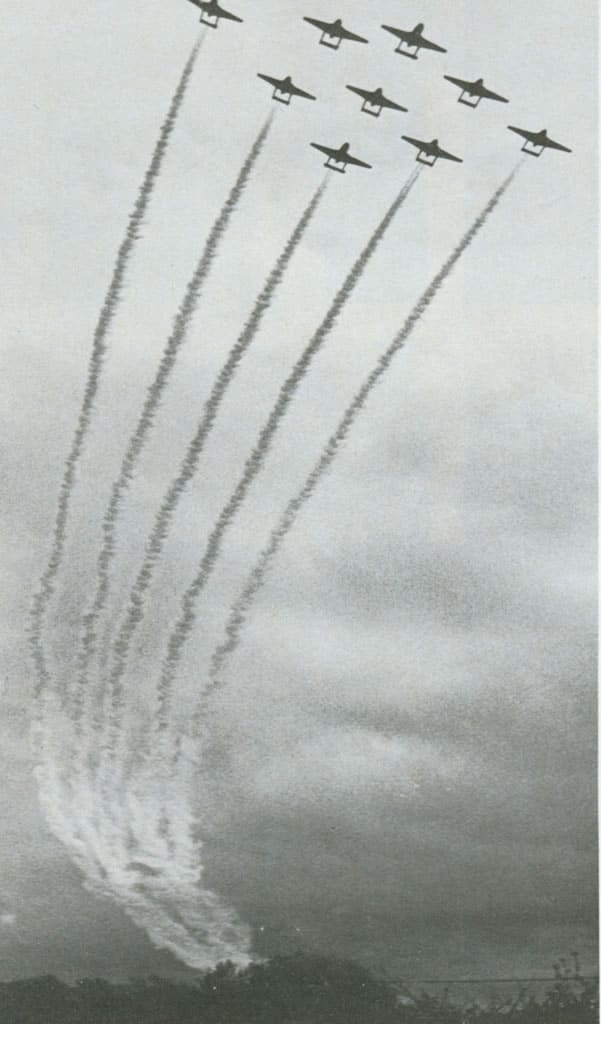
My only flight on Wednesday 8th October was as a member of a Diamond-9 flypast we did in Poverty Bay over the arriving five-nation naval fleet comprising 10 ships from Australia, Britain, Canada, New Zealand and United States. I flew again as number 7 of 9, but this time in Vampire FB5 NZ5770 on the 45 minute flight. As will be seen in the photograph above, the last 5 aircraft in the formation had been fitted with ‘smoke’ – this system comprised of a small tank of diesel within the engine bay fitted with a pump that was activated by the pilot pushing a switch on the control column to inject diesel into the jet wash aft of the tail pipe: simple but effective.


First of two flypasts on Thursday 9th October – There were two Diamond 9 flypasts on Thursday 9th October 1969: the first was for the Civic Ceremony held at Endeavour Park on Gladstone Road, the main street of Gisborne. Squadron boss, Sqn Ldr John Scrimshaw, was required to be in attendance at the Civic Ceremony, so he passed leadership of the Diamond 9 to our USN Exchange officer, Lt Cdr Fred Myers USN. Fred had done a couple of practices for timing purposes the previous day so he was ready to ‘nail it’ with a low, fast and ‘on time’ flypast. What transpired was an on time, but VERY low, flypast, much to the shock of our squadron CO who was there beside the official dais to witness it!
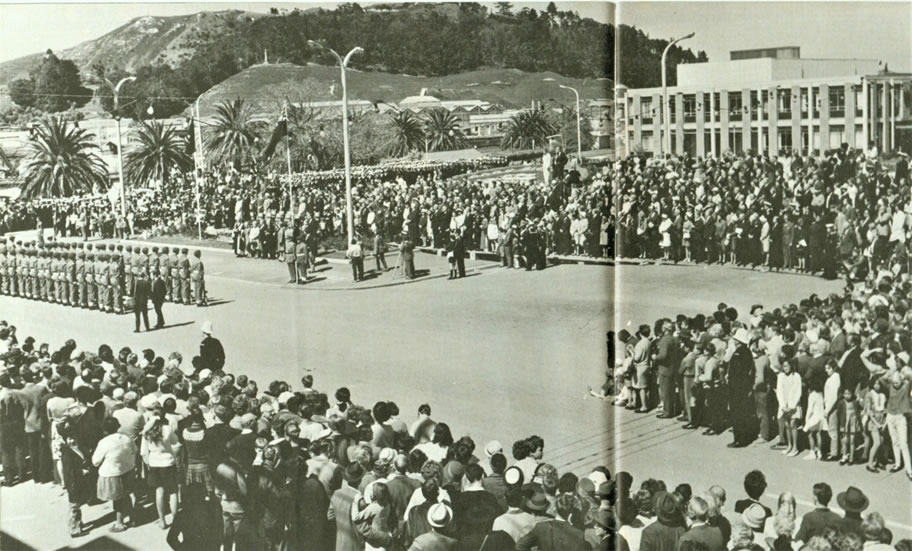
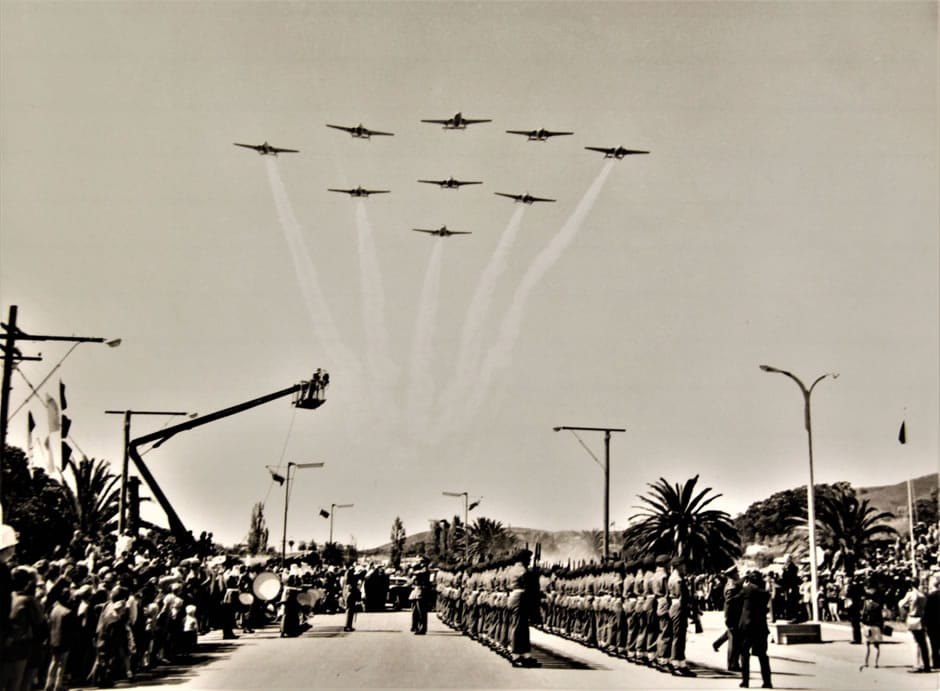

Lt Cdr Fred Myers USN #1
Plt Off Ian Wood #2 Plt Off Graham Bethell #3
Fg Off Graeme Thomson #4 Flt Lt Ken Gayfer #5
Flt Lt Ross Ewing – #6
Fg Off Jim Barclay #7 Fg Off Kenn Cox #8
Fg Off Jim Jennings & Wg Cdr Pat Neville #9
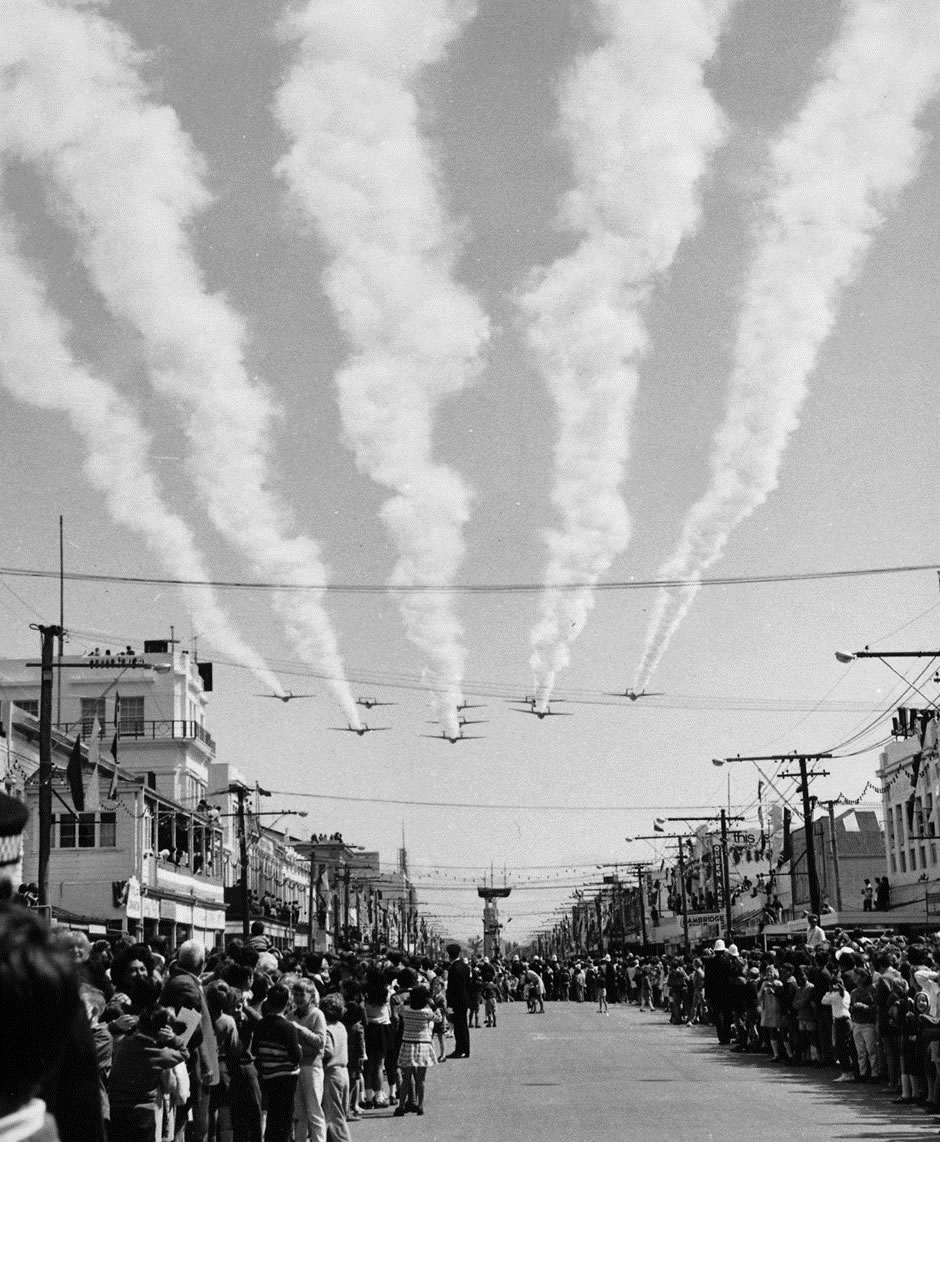
Wing Commander Pat Neville (later to be Chief of Air Staff RNZAF) was riding with Fg Off Jim Jennings in the Vampire T11 as #9 at the back, and lowest, of the formation. After we had skimmed past the Endeavour ship on a pole and the clock tower in the main street (see photo above), Flt Lt Ross Ewing as #6, and leader of the Box 4, said, “Are you still there 9?” Pat tried the stifle Jim from replying, and thereby hoped that Ross would think they were ‘scrapped-off’ on the clock tower! Back on the ground, someone asked Pat if that was low enough? “Low enough?”, said Pat, “Christ, being that low I was able to look under the verandas of the shops, and across the footpath I looked straight into the front window of Haldenstein’s men’s wear shop and saw the new pair of underpants I needed!”
Second Flypast on 9th October – The second flypast that day was for the official Government parade, reviewed by the Governor General, Lord Porritt, and held at Rugby Park, Gisborne in the afternoon. I flew Vampire FB5 NZ5774 on both flypasts on Thursday 9th October – the first was flight duration of 40 minutes, and the send 30 minutes.
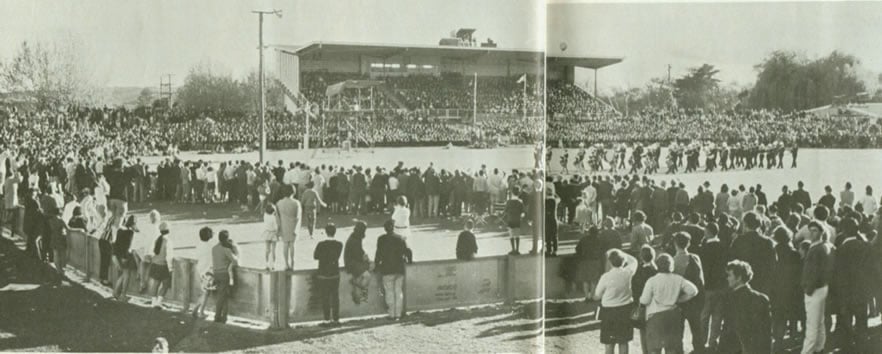

A non-attributable story about timing for the 75 Squadron flypast over Rugby Park went something like this:- The Boss of 75 Sqn, Sqn Ldr John Scrimshaw, led the afternoon 9-aircraft formation, and he devised a cunning plan in order that the Diamond 9 of Vampires would be exactly on time for the Royal Salute that was to be given after the Governor General had mounted the dais. As it didn’t matter from what direction the flypast came from, the Boss decided to fly an arc some 15 miles distant from Rugby Park as this would give him something like a 3 minute run at 300knots from the arc to the overhead.
Now, ‘someone’ had figured it would take 3 minutes from the entry of the official car at the main gate of Rugby Park before ‘the Gov’ was on the dais and the command for ‘Royal Salute’ had been given by the Parade Commander. Having settled on that plan, all the CO needed was a radio call from the 75 Squadron Flypast Controller located at Rugby Park telling him the Gov’s official car had arrived at the main gate, whereupon the Boss would wheel his formation through 90 degrees of turn and start his run-in to Rugby Park in order to be on time over the dais.
The best laid plans …. what transpired was a comical shambles. Because the grandstand was in the way, the Flypast Controller couldn’t see the main gate from the parade area, so he positioned another ‘spare’ RNZAF officer at the end of the grandstand with a view of both the main gate and the dais area; upon the arrival of the official car at the gate, the ‘spare’ officer was to raise his arm as a signal to the Flypast Controller that the Gov had arrived, whereupon the Controller would use his portable radio to advise the Boss to start his turn onto the run-in heading with his nine aircraft. Simple.
However, …… (the plot thickens) an old lady saw the ‘spare’ officer in uniform standing at the end of the grandstand and, possibly thinking he was policeman, asked him where the toilets were – whereupon our erstwhile ‘spare’ expert raised his arm to indicate ‘over there’; the Flypast Controller saw the arm signal and, thinking the Gov had arrived at the gate, promptly called the Boss with his jets to start his run-in. Alas, some 60 seconds later, the Flypast Controller realised the mistake and frantically called the Boss to tell him abort the run-in. The Boss turned away as sharply as he dared with the 9 ship of Vamps in close formation, but when heading away from Rugby Park he was soon called back in again – this time with an urgent ‘come now, quickly’. After a couple of hard turns, the tight Vampire formation was a ‘little strewn’, so the flypast over the dais was not at all in tight formation – instead it was a ragtag zoom, zoom-zoom, zoom-zoom-zoom. The debrief afterwards didn’t bear thinking about.
Looking after kids – In addition to our flying duties, junior pilots like me were sent to local schools to talk to the kids; and we looked after a lot of school groups who came to Gisborne airfield to visit 75 Squadron.
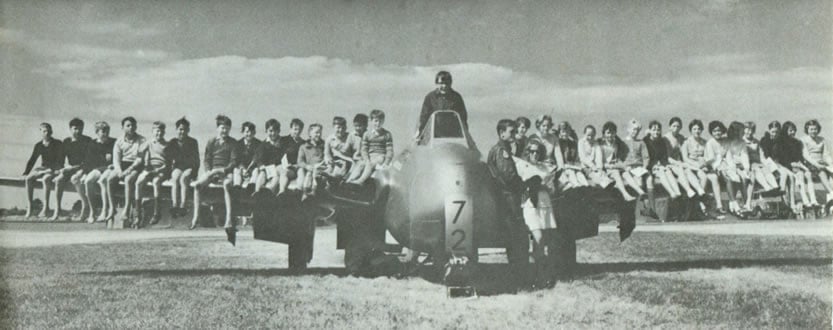

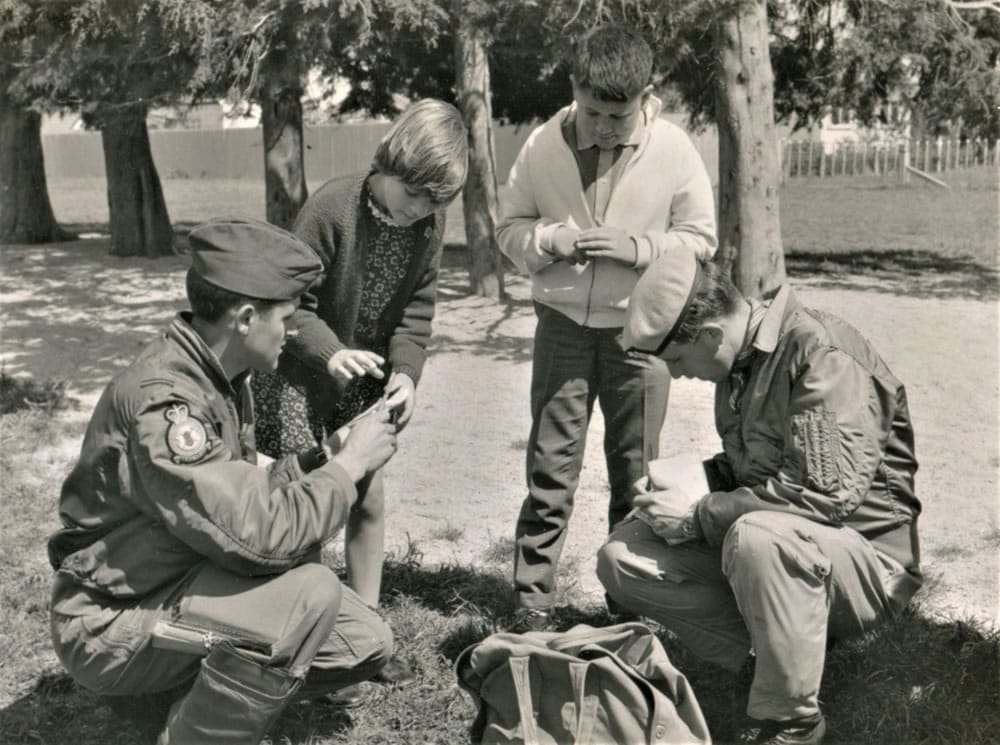
The Air Pageant – At the Cook Bi-Centenary Air Pageant held at Gisborne Airport on Saturday 11th October I was the PA commentator for the Vampire display that was flown by a five-aircraft 75 Squadron team. The team leader was CO 75 Sqn – Sqn Ldr John Scrimshaw AFC, No 2 was Fg Off ‘Fred’ Thompson, No 3 Lt Cdr Fred Myers USN, No 4 Flt Lt Ken Gayfer, and No 5 (and solo) Flt Lt Ross Ewing. Ross ‘scooped-out’ as he recovered from a low level inverted run over the airfield, and apparently I made an ‘inadvertent comment’ over the PA when I thought he would hit the ground in his recovery.
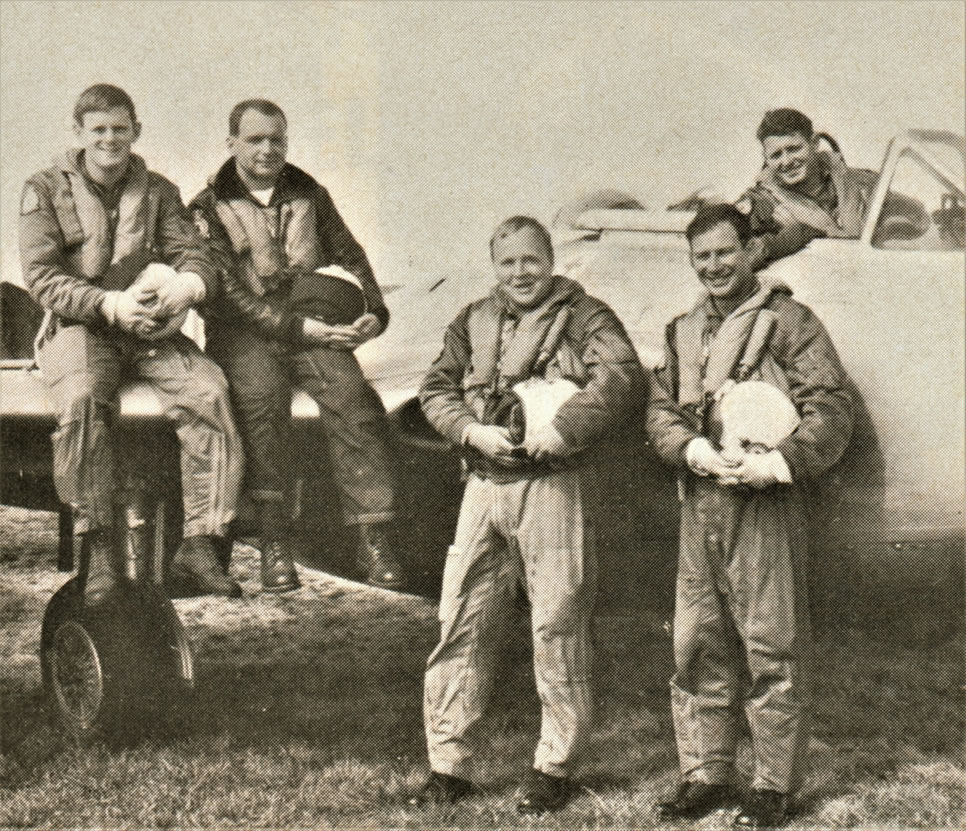
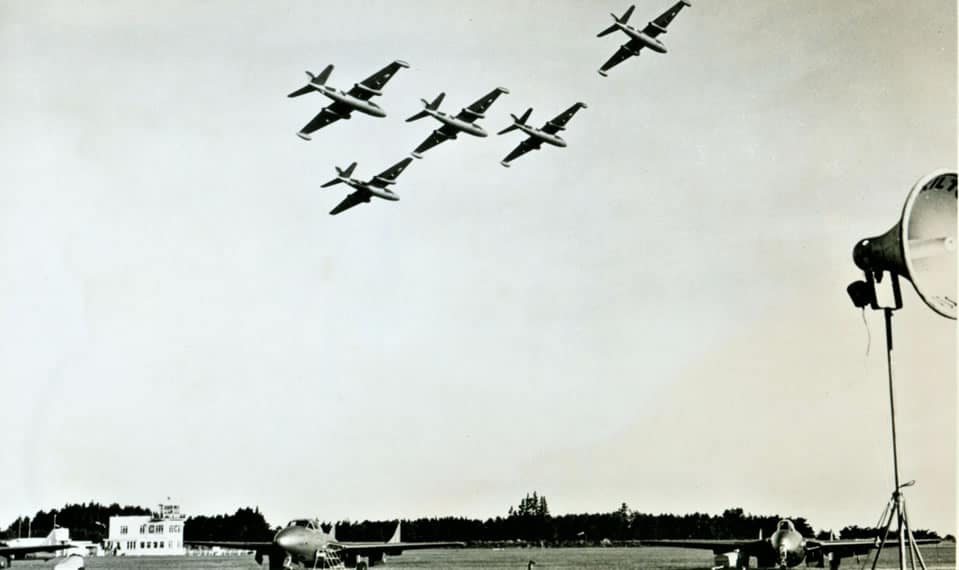
Homebound – On Monday 13th October 1969, after we had ‘struck’ the camp and packed up all the tents, we flew our next series of Diamond-9 formations. As we redeployed to Ohakea, I flew FB5 NZ5765 as number 7 of 9 in the 55 minute flight and we did a farewell flypast over Gisborne before another over Wairoa in Hawkes Bay, and a final one at Ohakea just to announce we were home.
Throughout Exercise Golden Kiwi, I flew 22 sorties totalling 18 hours 10 minutes flying time (including the transit flights from/to Ohakea) and gained further experience in operating from the shorter runway at Gisborne, employing weapons at an open sea weapons range, supporting FAC training, and generally having a great time with fellow fighter/ground attack pilots. In a nutshell, that was Exercise Golden Kiwi 1969.


Richard Ketchum
Posted at 00:39h, 29 MarchWow very interesting story thanks for sharing this. Have a great day
Dave Hamilton
Posted at 19:28h, 17 DecemberFabulous reading. I know JIim and Iggy well from my time in the RNZAF. 🙂
Jim Barclay
Posted at 15:59h, 29 DecemberHi Dave,
I’m pleased you found something of interest on this blogsite! Cheers, Jim
GRAEME JOHN MUGGERIDGE
Posted at 10:12h, 23 OctoberThanks for Golden Kiwi story Jim. I was a very young 19 year old LAC erk Air Radio Mech on 75 SQN back then and a day visitor via Para Dak from Ohakea for the day.
I remember the scorched grass from the ‘bunsen burner whistling wheelbarrows’ on Gisborne airfield and visiting the new Captain Cook memorial that day. The SQN made quite a show at Gisborne.
I remember most of the SQN pilots of that era. Today, I’m a young 74 year old.and still work in the Air Force as an Av Tech.
Cheers,
Graeme Muggeridge Civvie Avionics Tech Whenuapai Base Auckland Oct 2023
Simon Crase
Posted at 20:25h, 19 DecemberI noticed your reference to “gonophones”. My father was on Guadacanal around 1943, and he told me that a gonophone was a Japanese helmet, with a hole drilled in it, welded to a pipe that was embedded in the ground. It was used as you describe it. He also mentioned a “super gonophone”, with multiple helmets that were connected back to one pipe.